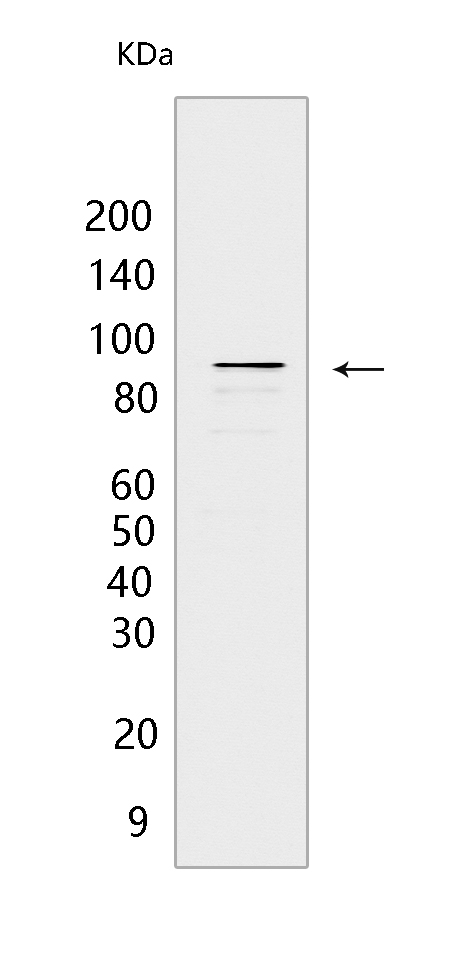Cyclin F Rabbit mAb [5884]Cat NO.: A93130
Western blot(SDS PAGE) analysis of extracts from HT-29 cells.Using Cyclin F Rabbit mAb [5884] at dilution of 1:1000 incubated at 4℃ over night.
Product information
Protein names :CCNF,FBX1,FBXO1,CCNF_HUMAN,Cyclin-F
UniProtID :P41002
MASS(da) :87,640
MW(kDa) :90 kDa
Form :Liquid
Purification :Protein A purification
Host :Rabbit
Isotype :IgG
sensitivity :Endogenous
Reactivity :Human
- ApplicationDilution
- 免疫印迹(WB)1:1000-2000
- The optimal dilutions should be determined by the end user
Specificity :Antibody is produced by immunizing animals with a synthetic peptide at the sequence of Human Cyclin F
Storage :Antibody store in 10 mM PBS, 0.5mg/ml BSA, 50% glycerol. Shipped at 4°C. Store at-20°C or -80°C. Products are valid for one natural year of receipt.Avoid repeated freeze / thaw cycles.
WB Positive detected :HT-29 cells
Function : Substrate recognition component of a SCF (SKP1-CUL1-F-box protein) E3 ubiquitin-protein ligase complex which mediates the ubiquitination and subsequent proteasomal degradation of target proteins (PubMed:20596027, PubMed:22632967, PubMed:27653696, PubMed:26818844, PubMed:27080313, PubMed:28852778). The SCF(CCNF) E3 ubiquitin-protein ligase complex is an integral component of the ubiquitin proteasome system (UPS) and links proteasome degradation to the cell cycle (PubMed:8706131, PubMed:20596027, PubMed:27653696, PubMed:26818844). Mediates the substrate recognition and the proteasomal degradation of various target proteins involved in the regulation of cell cycle progression and in the maintenance of genome stability (PubMed:20596027, PubMed:22632967, PubMed:27653696, PubMed:26818844). Mediates the ubiquitination and proteasomal degradation of CP110 during G2 phase, thereby acting as an inhibitor of centrosome reduplication (PubMed:20596027). In G2, mediates the ubiquitination and subsequent degradation of ribonucleotide reductase RRM2, thereby maintaining a balanced pool of dNTPs and genome integrity (PubMed:22632967). In G2, mediates the ubiquitination and proteasomal degradation of CDC6, thereby suppressing DNA re-replication and preventing genome instability (PubMed:26818844). Involved in the ubiquitination and degradation of the substrate adapter CDH1 of the anaphase-promoting complex (APC/C), thereby acting as an antagonist of APC/C in regulating G1 progression and S phase entry (PubMed:27653696). May play a role in the G2 cell cycle checkpoint control after DNA damage, possibly by promoting the ubiquitination of MYBL2/BMYB (PubMed:25557911)..
Tissue specificity :Widely expressed, with expression detected in the heart, brain, placenta, lung, liver, skeletal muscle, kidney and pancreas..
Subcellular locationi :Nucleus. Cytoplasm, perinuclear region. Cytoplasm, cytoskeleton, microtubule organizing center, centrosome, centriole.
IMPORTANT: For western blots, incubate membrane with diluted primary antibody in 1% w/v BSA, 1X TBST at 4°C overnight.


